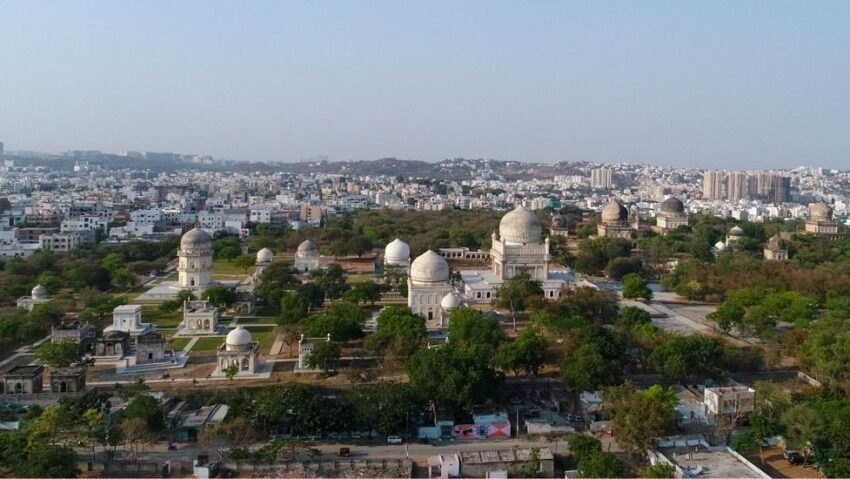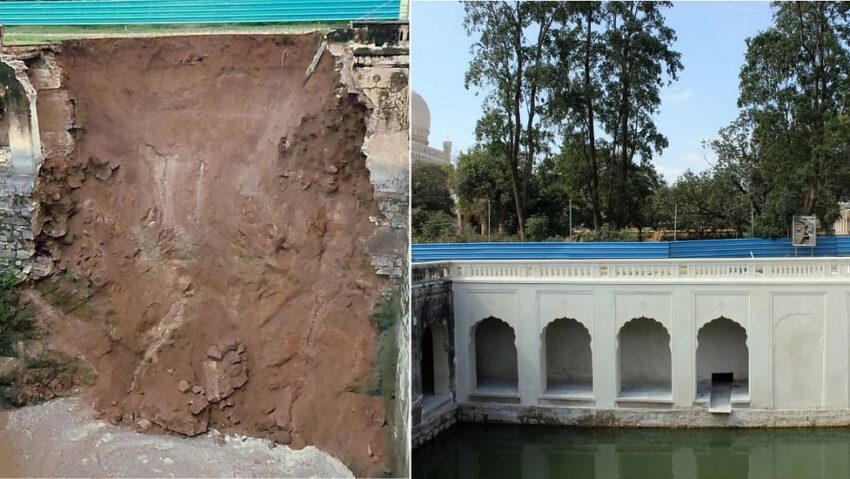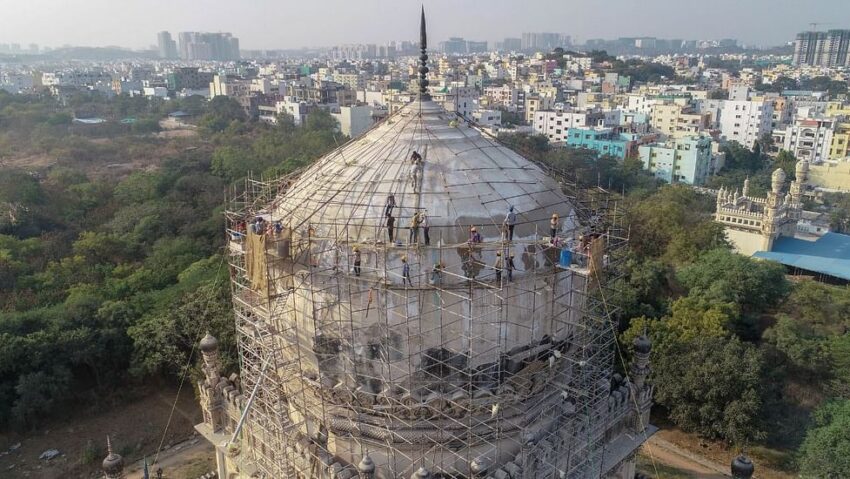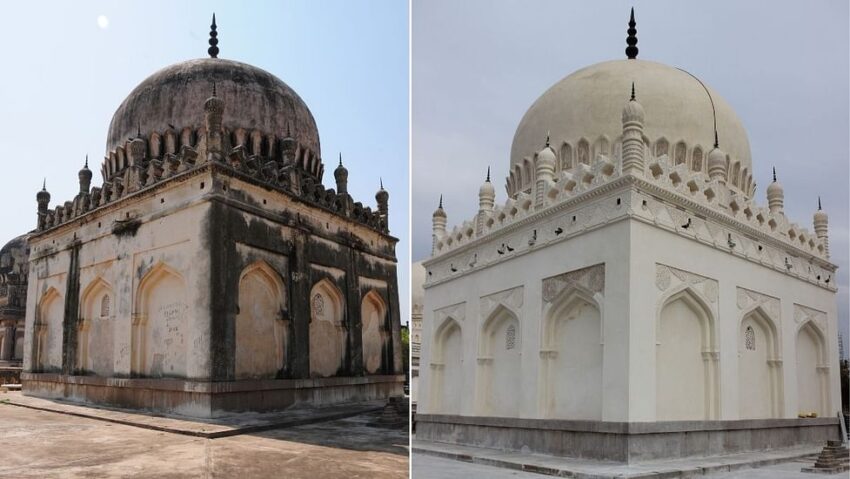Hyderabad’s historical necropolis – the Qutub Shahi Tombs are under archeological preservatory mode since a decade, the caretaker ‘Aga Khan Trust for Culture’ has been preserving and restoring the Qutb Shahi Tombs. And in it lies the founder of Hyderabad. This project restoration is now at the last stages to complete. Makes the historical monument to be seen and restored for centuries.

One afternoon in the sweltering heat of Hyderabad, a mason laboriously chipped through layers of 20th-century cement while precariously poised on a bamboo scaffolding. Something appeared out of nowhere through the sand. The dome and facade of Muhammad Quli Qutb Shah’s mausoleum were covered for centuries with intricate blue and green glaze tile patterns that occasionally showed through. The deteriorated tiles now provide a window into life in the 16th century, when the mausoleum was built.
The Aga Khan Trust for Culture needed ten years to restore this element of Hyderabad’s past. A necropolis, however, was there all along, hiding in plain sight. And inside of it was Hyderabad’s founder.
The mighty and wealthy Qutub Shahi dynasty ruled the Golconda sultanate for 171 years before Aurangzeb conquered the Deccan in 1687. Its fifth ruler, Quli Qutb Shah, son of a Muslim father and Hindu mother, established Hyderabad and built the Charminar.
If the Golconda fort, less than 10 minutes away, is the famous tourist spot, then the Qutb Shahi tomb complex is the less frequented, friendly neighbourhood hangout. That is until the Aga Khan Trust stepped in. The Trust, which has turned Delhi’s Humayun’s Tomb complex and Sunder Nursery into jewels in the capital’s crown, is restoring the Hyderabad heritage structure into an archaeological park.
According to Ratish Nanda, conservation architect and CEO of Agha Khan Trust for Culture (AKTC) India, “The Qutb Shahi necropolis is unique with no comparable site anywhere in the world, with over 100 structures — mausoleums, funerary mosques, stepwells, garden structures, and archaeological remains — representing every decade of the Qutb Shahi rule.”
How is a necropolis restored?

Veteran actor Mohammad Baig, like the majority of Hyderabadis, has good recollections of his childhood in the city, which included numerous picnics at the Qutb Shahi tombs because of their “uniqueness and breath-taking architecture.”
“I don’t think there is another example of a place like Qutb Shahi where six rulers of the same dynasty are buried at the same place,” he said.
The Qutub Shahi Tombs contain 80 monuments — including 40 mausoleums, 23 mosques, seven-step walls (baoli), a hamam, pavilions, tanks, wells, garden structures, and enclosure walls.
So, how do you restore such a place?
According to Aga Khan’s Nanda, there are “no templates” to redevelop and restore a monument, but the process is rigorous.
“Each process includes architectural documentation, archival research, writing a conservation plan, peer reviews, high degree of supervision by an interdisciplinary team, and of course, master craftsmen,” he said. But when the magic happens, its effect is clear. The footfall of tourists to Delhi’s Humayun’s Tomb complex and Sunder Nursery has increased manifold after the Trust’s restoration project — it now receives 20 lakh visitors annually.
In January 2013, an MoU was signed between the Department of Archaeology and Museums (now Heritage Telangana), the Quli Qutb Shah Urban Development Authority, Aga Khan Foundation and the Aga Khan Trust for Culture for conservation and landscape development of the tomb complex. The funds came from AKTC, Tata Trust, US Ambassadors Fund for Cultural Preservation, IndiGo CSR, and the German Embassy. No funds have been sought from the government.
As it is being revamped, the government of India has nominated the Qutb Shahi Tombs as a UNESCO World Heritage Site. “It is a long, tedious process and several factors like tourism potential are the criteria to designate a monument as a world heritage site. If a monument clears even one criterion, it can be declared that,” said Dr Shikha Jain, director of Gurugram-based Dronah Foundation.

The landscape master plan for Qutb Shahi Tombs was developed by architect M. Shaheer, who envisaged the 106-acre complex into three zones — the archaeological zone, a visitor facility zone and an ecological zone. “We have not buried archaeological remains, rather have tried to preserve the sanctity in the best way possible,” said Nanda, speaking to #KhabarLive about the elaborate design patterns involving dragons and birds that were unearthed.
But when you restore a landscape, you don’t just look at the monuments. An exhaustive tree survey was undertaken that mapped 3,300 existing trees covering 72 species. Over 2,000 tree saplings have been planted along the edge of the site to create a natural buffer.
While the Qutb Shahi tombs are state-protected monuments, the Golconda Fort, in the same vicinity, is designated a monument of national importance. But according to Hyderabad-based historian Sajjad Shahid, this is not an anomaly.
Hyderabad, take a look
Given its record and success, many governments may be vying for the Aga Khan Trust’s services.
“We work wherever the government invites us,” said Nanda about AKTC’s method of choosing the monuments. And for now, their “hands are full” with Hyderabad and Delhi. The foundation is also working on the Nizamuddin Urban Renewal Initiative.
Over 2,500 measured drawings, condition reports, topographical survey of the 106 acres and more went into the Hyderabad restoration plan. And you cannot rebuild history without archives. A sustained effort at archival research has already led to the collection of over 500 images—some dating back to the 1860s. While a major part of the restoration, which began in 2013, has been completed, the pandemic and multiple litigations have pushed the deadline from 10 years to 14 years now.

Will all these efforts make the city’s residents take a second look at the Qutb Shahi tombs?
Like India metaphorically is known by the Taj Mahal, Charminar is the cultural identity of Hyderabad,” said Baig, addressing the “laid back” attitude of Hyderabadis. “There is a saying in Hindi, “Ghar ki murgi daal barabar (familiarity breeds contempt).”
The “true impact” of the repair will be felt in the “coming 4-5 years,” according to Nanda, even though tourist interest is changing. The Qutb Shahi Tombs are currently gradually gaining ground in the popularity stakes. And beneath them are the sleeping hakims, kings, queens, princesses, and generals. #KhabarLive #hydnews #hyderabadlive
